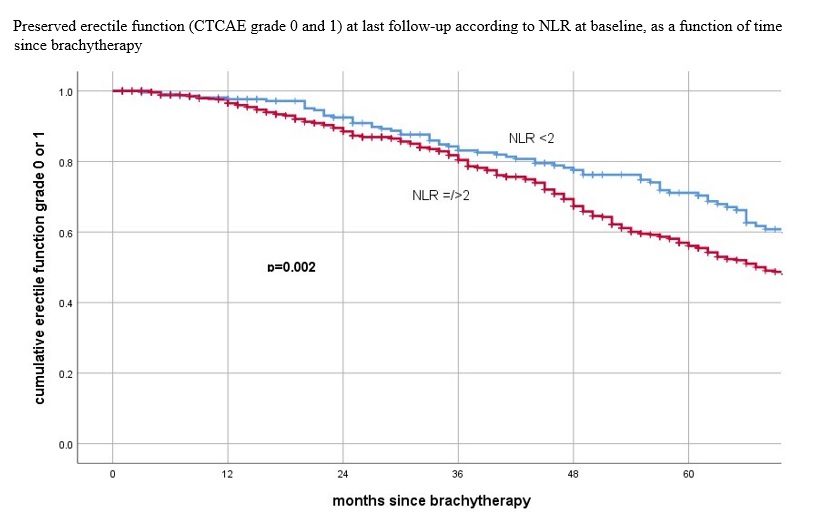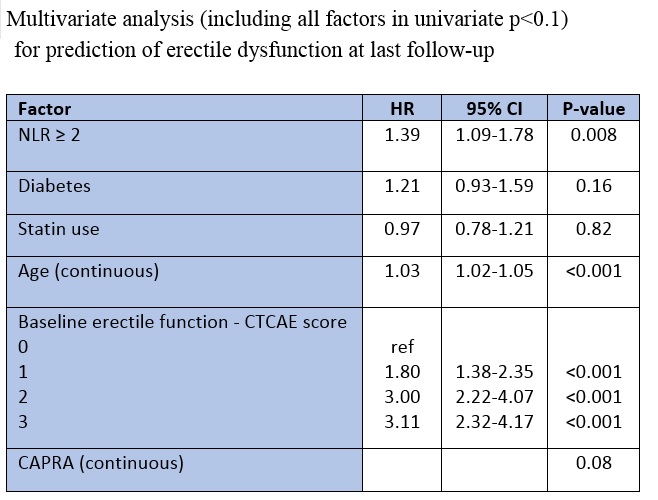Back
Poster, Podium & Video Sessions
Podium
PD22: Prostate Cancer: Localized: Radiation Therapy
PD22-11: Subclinical Inflammation as a Predictor for Erectile Dysfunction after Brachytherapy for Localized Prostate Cancer
Saturday, May 14, 2022
11:10 AM – 11:20 AM
Location: Room 252
Laurianne Rita Garabed*, Daniel Taussky, Guila Delouya, Daniel Liberman, Montreal, Canada
- LG
Podium Presenter(s)
Introduction: Neutrophil-to-lymphocyte ratio (NLR), a marker for subclinical inflammation, has been previously shown to be associated with erectile dysfunction (ED). Treatment of localized prostate cancer (PCa) is also associated with a greater risk of ED. In this study, we aimed to determine the potential predictive value of the NLR on ED after prostate brachytherapy (PB) for PCa.
Methods: Between July 2005 and January 2021, 842 patients were included in this retrospective study of a prospectively maintained database. ED was assessed using the Common Terminology Criteria for Adverse Events (CTCAE) physician-reported scale. Patient characteristics and erectile function at last follow-up were compared for patients with a baseline NLR <2 and =2. Univariate and multivariate analyses were performed to evaluate the predictive value of baseline NLR =2 on post-PB ED.
Results: Baseline NLR=2 was found to be a statistically significant predictor of post-PB ED on both univariate (p=0.002) and multivariate analyses (p=0.008). Furthermore, the difference in ED prevalence between the NLR <2 and NLR =2 groups became more pronounced with longer follow-up after PB. The ED rate at 5 years post-PB was 43% for the NLR=2 group, compared to 29% for the NLR <2 group.
Conclusions: In a large cohort of patients with PCa who underwent PB, it was found that NLR was a predictor of post-treatment ED, even after adjusting for available covariates, including age and known risk factors for endothelial dysfunction.
Source of Funding: None


Methods: Between July 2005 and January 2021, 842 patients were included in this retrospective study of a prospectively maintained database. ED was assessed using the Common Terminology Criteria for Adverse Events (CTCAE) physician-reported scale. Patient characteristics and erectile function at last follow-up were compared for patients with a baseline NLR <2 and =2. Univariate and multivariate analyses were performed to evaluate the predictive value of baseline NLR =2 on post-PB ED.
Results: Baseline NLR=2 was found to be a statistically significant predictor of post-PB ED on both univariate (p=0.002) and multivariate analyses (p=0.008). Furthermore, the difference in ED prevalence between the NLR <2 and NLR =2 groups became more pronounced with longer follow-up after PB. The ED rate at 5 years post-PB was 43% for the NLR=2 group, compared to 29% for the NLR <2 group.
Conclusions: In a large cohort of patients with PCa who underwent PB, it was found that NLR was a predictor of post-treatment ED, even after adjusting for available covariates, including age and known risk factors for endothelial dysfunction.
Source of Funding: None



.jpg)
.jpg)